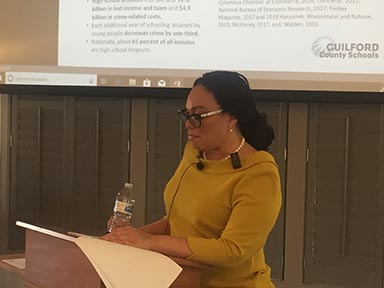Earlier this year, a major new facilities study of Guilford County Schools found that the school system needed nearly $1.5 billion in repairs, new buildings and other enhancements. And it’s now becoming clear how school officials will justify that major new expense.
Their message? Money spent on schools is an investment that pays off in the end more than it costs.
In 2019, school officials and school advocates will have the job of selling county voters and taxpayers on the idea of making a very large investment in the school system and it’s now becoming crystal clear that the main sales pitch will be that improving the schools will enhance economic development in Guilford County.
That theme was front and center recently when Guilford County Schools Superintendent Sharon Contreras addressed the Guilford County Board of Commissioners at the board’s annual retreat for the first time since the study found that the school system needed the massive infusion of dollars.
“Communities with higher performing schools have higher levels of economic development,” Contreras told the board.
This is certainly the right message for the commissioners because the Guilford County Board of Commissioners has made economic development a top priority. The board spends a great deal of time on the topic, Chairman Alan Branson said in December that that is his focus in 2019 and Guilford County Manager Marty Lawing has listed economic development as a priority for years.
One of the main things that attracts businesses to an area is a trained and skilled workforce and Contreras told the board that’s exactly what the school system would deliver given the proper resources.
At the meeting, Contreras pointed to recent research by the Piedmont Triad Partnership that showed this region has seen significant growth in its advanced manufacturing needs – including new jobs in aerospace, plastics and medical device manufacturing.
“However, we also know that 75 percent of employers in Guilford County are having difficulty filling jobs,” she added. “We have the jobs right now that we cannot fill according to the Piedmont Triad Partnership. This means there is some sort of misalignment between the needs of our students, what we are preparing them to do, and the actual jobs in Guilford County.”
According to Contreras, there is a lucrative “return on investment” whenever the county puts money into the school system’s needs such as new career academies, additional training programs and upgrades to educational facilities and equipment.
“Even modest investments in education outweigh the costs of what you put in,” Contreras told the board.
“Our goal is not to improve test scores,” she added.
She said that, instead, the goal is to improve the lives and outcomes of every student so they can sustain their lives without others having to intervene.
The Guilford County commissioners are also very aware of how much money the county spends each year delivering services to those who aren’t able to sustain themselves.
Guilford County voters are likely to see a large school bond referendum on the ballot in the not too distant future and the outcome of that vote will be the biggest indicator of how well the school system has made its case this year.


The first thing we can do to help the Guilford County school system is to get rid of this struggling invalid person we call a school superintendent and hire a REAL fully faculties human who can handle the job. She is the real reason that our schools has reduced its capabilities to this lower status. WE can do better that this. Lets make the change NOW and bring out schools back to how they were before we hired this invalid to be over our schools.
Under the leadership of this superintendent our schools will never get any better no matter how much money is allocated for this purpose. How could our schools have fallen soo low since our last fine qualified superintendent was in charge of our schools. This is a shame for all of our students.
If they’re not forever shilling that it’s “for the children” these bold bureaucrats are selling us on it being a great “investment”. What tosh! They’re overpaid and overmanned, indifferent and incompetent, part-time parasites with a penchant for Lexuses and Cadillacs.
Only a radical voucher based system will break their monopoly – and give our kids a chance.
Contrary to Martin’s two posts (above) the Guilford County Schools Superintendent is not the problem with education in this county. She is a highly compensated employee of the school board and is charged with implementing the policies of the school board. Since the board has not fired her, me must assume that they approve of what she has done and is doing. If she were to leave, the board would hire another superintendent to implement the same failed policies and nothing would improve. Many people couldn’t wait to “get Terry Grier outta here.” It didn’t help. What we should have done was get the incumbents on the school board outta here. That might have resulted in improved education in our schools. As long as we have the same people on the board, we can expect the same lack of positive results (and the same broken-record clamoring for massive amounts of increased spending).